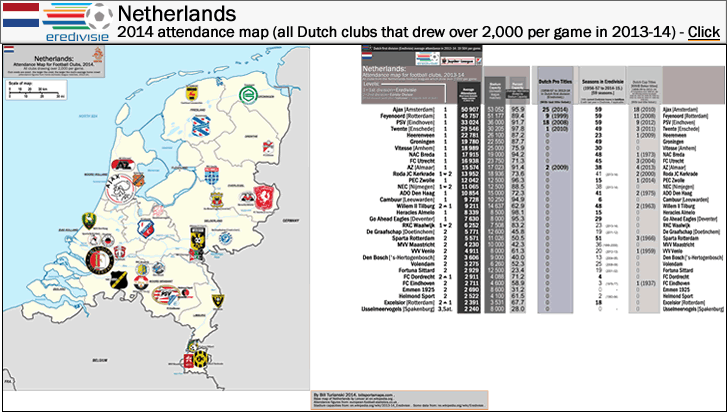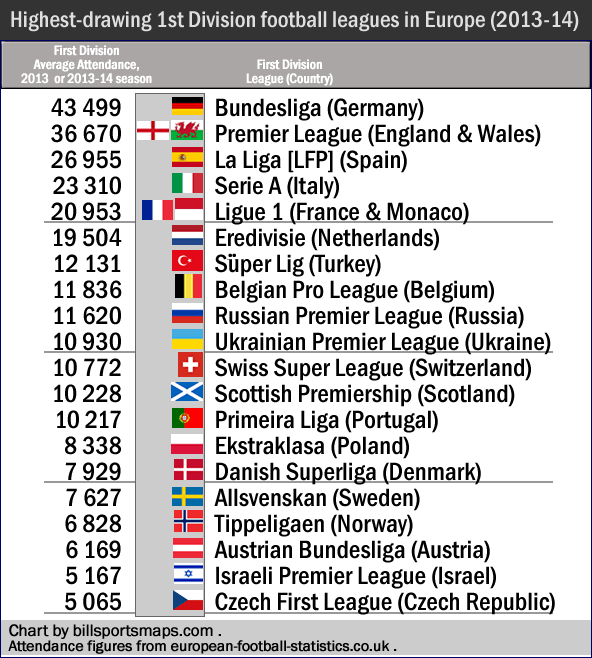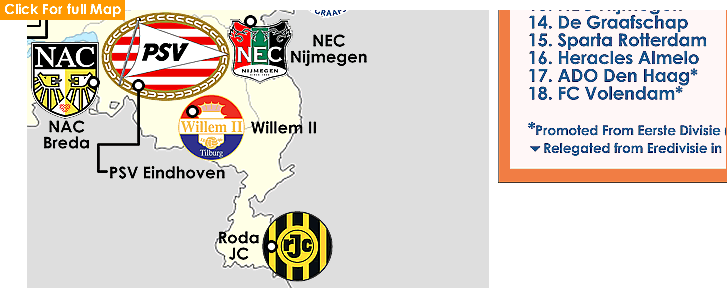
Netherlands: 2022-23 Eredivisie – Location-map, with 3 charts: Attendance [current]; Seasons-in-1st-Division (current clubs) & Dutch professional titles list
By Bill Turianski on 12 January 2023; twitter.com/billsportsmaps.
Links…
-Summary – Eredivisie – Netherlands – results, fixtures, tables, stats, etc (soccerway.com).
-2022-23 Eredivisie (en.wikipedia.org).
-worldfootball.net/competition/[Eredivisie - Overview].
The map shows the 18 clubs in the 2022-23 Eredivisie, the top-flight of the Netherlands. The Eredivisie was founded in 1956, two years after the introduction of professionalism in the Netherlands. That makes this the 67th season of the competition. Currently [12 January 2023], after 15 of 36 rounds, Feyenoord leads, with Ajax and PSV 3 points back, and Twente and AZ 4 points back.
On the left-hand side of the map-page is an Attendance chart which features 3 things: current Average Attendance (to 9 January 2023, with 15 of 36 rounds played), Venue-capacity, and Percent-capacity.
Currently, the Dutch top flight is drawing very well. Eleven of the eighteen teams are drawing above 90%-capacity. Those 11 teams drawing above 90%-capacity are: Feyenoord Rotterdam, NEC [Nijmegen], Go Ahead Eagles [of Deventer], Ajax [Amsterdam], Twente [Enschede], Fortuna Sittard [of Limburg], just-promoted Excelsior [of Rotterdam], just-promoted Volendam [located just north of Amsterdam in Nord-Holland], Cambuur Leeuwarden [of Freisland], just-promoted Emmen [of Emmen in Drenthe], and Sparta Rotterdam. [Note: Feyenoord are currently playing to 100%-capacity at their stadium, De Kuip, but this is a limited capacity of 47,500, which is about 3,600 less than the total seated-capacity of the stadium.]
At the right-hand side of the map-page are two charts. The top chart shows the Seasons-in-1st-division for the current clubs. Also listed are the consecutive seasons each club has currently spent in the top-flight. Longest serving clubs are the big 3 of the Netherlands – Ajax (of Amsterdam), Feyenoord (of Rotterdam), and PSV (of Eindhoven). All 3 were founding members of the Eredivisie, and all 3 have never been relegated. The second chart is the all-time pro titles list for the Netherlands. As mentioned, the Eredivisie was established two years after Dutch clubs could turn pro. So I have included the winners of the final two 48-team Dutch National Championships, in 1954-55 (winner: Willem II [of Tilburg]) and 1955-56 (winner: Rapid JC [of Kerkrade]).
The map itself includes the 12 provinces, and the 14 largest cities of the Netherlands. At the foot of the map, the populations of those 14 largest Dutch cities are listed (with the provinces they are located in). Finally, I added all the major rivers and waterways of the Netherlands, including the main canals.
___
-Thanks to Lencer at en.wikipedia.org, for the blank map of Netherlands, File:Netherlands location map.svg.
-Thanks to Rob984 at File:EU-Netherlands_(orthographic projection).svg.
-Thanks to the contributors at Eredivisie (en.wikipedia.org).









